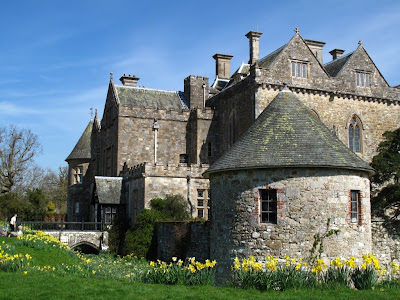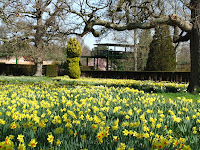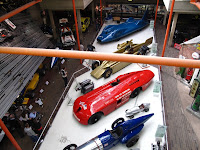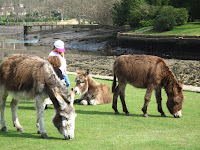
 Since Thursday, we have been enjoying the sort of weather everyone would have liked for the Easter break. Fortunately it lasted for the weekend, and we set off for Beaulieu, one of the most visited stately homes in England. The reason for this is that
Since Thursday, we have been enjoying the sort of weather everyone would have liked for the Easter break. Fortunately it lasted for the weekend, and we set off for Beaulieu, one of the most visited stately homes in England. The reason for this is that  Beaulieu's current owner, 83year old Lord Montagu, developed the National Motor Museum in memory of his father, who was an early champion of the motor car, when it was considered smelly, noisy and dangerous.
Beaulieu's current owner, 83year old Lord Montagu, developed the National Motor Museum in memory of his father, who was an early champion of the motor car, when it was considered smelly, noisy and dangerous. The Motor Museum has an amazing collection of cars, motorbikes and other vintage vehicles. There is also a collection of James Bond vehicles and cars from the TV show Top Gear.
The Motor Museum has an amazing collection of cars, motorbikes and other vintage vehicles. There is also a collection of James Bond vehicles and cars from the TV show Top Gear. A monorail (or vintage bus) takes visitors through the Motor Museum to Beaulieu Palace. This stunning stately Victorian home is modelled on the Abbey nearby, which was dismantled by Henry 8th. While there, we also did a behind the scenes tour of the private wing with a very entertaining Irish guide, dressed as the butler, and learnt a lot of family history. The gardens were full of daffodils, and the Palace was complimented by a moat entirely carpeted with daffodils.
A monorail (or vintage bus) takes visitors through the Motor Museum to Beaulieu Palace. This stunning stately Victorian home is modelled on the Abbey nearby, which was dismantled by Henry 8th. While there, we also did a behind the scenes tour of the private wing with a very entertaining Irish guide, dressed as the butler, and learnt a lot of family history. The gardens were full of daffodils, and the Palace was complimented by a moat entirely carpeted with daffodils. From Beaulieu, we started a circular driving tour, and the next stop was Exbury Gardens. These were developed by Lionel de Rothschild after World War I. The gardens are famous for their azaleas and rhododendrons and although we only saw the early flowering varieties, the daffodil meadow was well worth the visit. In a month's time, the garden will be a blaze of colour.
From Beaulieu, we started a circular driving tour, and the next stop was Exbury Gardens. These were developed by Lionel de Rothschild after World War I. The gardens are famous for their azaleas and rhododendrons and although we only saw the early flowering varieties, the daffodil meadow was well worth the visit. In a month's time, the garden will be a blaze of colour. The circular drive took us through minor roads around the New Forest. Named “new” nearly 1,000 years ago by William the Conqueror, who developed it as his favourite hunting grounds.
The circular drive took us through minor roads around the New Forest. Named “new” nearly 1,000 years ago by William the Conqueror, who developed it as his favourite hunting grounds.The final stop of the day was the church in the lovely town of Lyndhurst. This Victorian church has a painting behind the altar by Lord Leighton and two stained glass windows by William Morris and Sir Edward Burne-Jones.




No comments:
Post a Comment